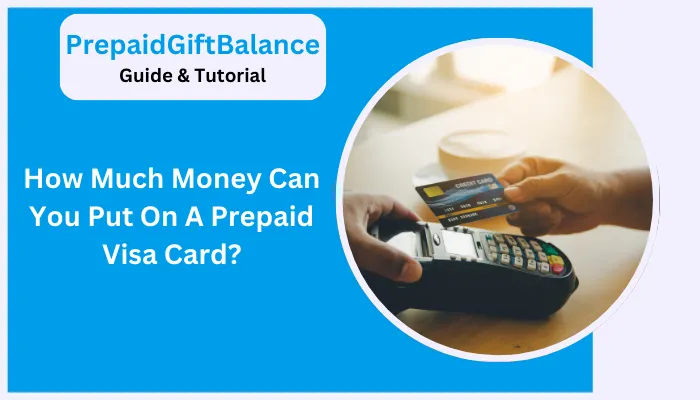Many people wonder, How much money can you put on a prepaid Visa card? These cards are popular for budgeting, gifting, and everyday expenses, offering convenience and security. However, the loading limits vary depending on the card provider and type. Understanding these limits helps you plan your finances effectively and avoid unexpected restrictions.
Whether you use a PrepaidGiftBalance card for travel, online shopping, or daily purchases, knowing the maximum amount you can load ensures you can manage your money effectively without unexpected restrictions.

What Are the Load Limits on a Prepaid Visa Card?
Prepaid Visa cards come with specific loading limits, which vary by issuer and card type. These limits are set to prevent fraud, comply with banking regulations, and ensure secure transactions.
Several factors determine How Much Money Can You Put On A Prepaid Visa Card?
- Card Issuer Policies: Different banks and financial institutions impose varying limits.
- Card Type: General-purpose reloadable (GPR) cards, gift cards, and payroll cards have different maximum limits.
- Verification Level: Some cards allow higher limits if the user provides identity verification.
- Regulatory Requirements: Financial regulations may impose maximum load limits to prevent money laundering.
- Cardholder Agreement: Some issuers set daily, weekly, or monthly limits on loading funds to manage risk and fraud.
For more details on your specific card’s limits, always refer to the cardholder agreement or contact the issuer directly.
Typical Load Limits for Prepaid Visa Cards
The exact amount you can load onto a prepaid Visa card depends on the issuer and type. Below is a general guide to common load limits:
| Card Type | Minimum Load | Maximum Load |
|---|---|---|
| Prepaid Gift Card | $10 | $500 – $1,000 |
| General Reloadable | $20 | $5,000 – $10,000 |
| Payroll Prepaid Card | Varies | $10,000 – $20,000 |
| Travel Prepaid Card | $50 | $5,000 – $15,000 |
Most general-purpose prepaid Visa cards allow up to $10,000 in total loads, but some premium or payroll cards may have higher limits. Always check with the card issuer for specific details.
How to Load Money Onto a Prepaid Visa Card?
Once you determine How Much Money Can You Put On A Prepaid Visa Card?, the next step is loading funds onto it. There are several ways to add money to your card:
Common Reload Methods
- Direct Deposit: Many prepaid cards support direct deposit from an employer or government benefits, making them a convenient alternative to traditional bank accounts.
- Bank Transfer: You can transfer funds from a linked bank account, which is useful for managing recurring payments.
- Cash Reload: Retailers offer cash reloading services at checkout or via in-store kiosks. Some common locations include Walmart, CVS, and Walgreens.
- Mobile Check Deposit: Some prepaid card providers allow check deposits via mobile apps, adding convenience for users who receive paper checks.
- Online Transfers: Send funds from digital wallets like PayPal, Venmo, or Cash App to your prepaid card.
- Retail Locations: Some issuers have partnerships with retail stores where you can reload your card for a small fee.
Each method may have its own processing time and fees, so always check before reloading your card. Some methods, such as cash reloads, may come with fees ranging from $3 to $6 per transaction, while direct deposit is often free.
Pros and Cons of Prepaid Visa Load Limits
Understanding How Much Money Can You Put On A Prepaid Visa Card? helps you maximize its benefits while avoiding restrictions.
Benefits:
- Budget Control: Prepaid Visa cards prevent overspending since you can only use preloaded funds.
- Security: If lost or stolen, the damage is limited to the card balance, reducing financial risks.
- Convenience: Widely accepted for online and in-store purchases, making them ideal for travel and e-commerce.
- No Credit Check: Unlike credit cards, prepaid cards don’t require a credit check, making them accessible to individuals with low or no credit.
- Alternative to Traditional Banking: Some individuals use prepaid cards in place of traditional checking accounts to manage their finances.
- Parental Controls: Parents can load a set amount onto a prepaid card for their children, ensuring controlled spending.
Limitations:
- Reload Fees: Some cards charge fees for adding money, especially at retail locations.
- Spending Caps: Daily spending limits may apply, restricting high-value transactions.
- Inactivity Fees: Some cards charge fees if unused for a period, which can reduce your balance over time.
- No Credit Building: Unlike credit cards, prepaid cards don’t improve your credit score, since they don’t involve borrowing money.
- Limited ATM Access: Some prepaid cards charge high ATM withdrawal fees or have limited networks.
For optimal use, always review your card’s terms and conditions to understand its specific benefits and limitations.
Conclusion
So, in conclusion, the answer to How much money can you put on a prepaid Visa card? depends on the card type, issuer policies, and verification levels. Generally, limits range from $500 to $20,000. Understanding these restrictions ensures you choose the right prepaid Visa card and manage your finances without unexpected limitations.
If you’re considering getting a prepaid Visa card, research the available options and verify the limits with your card issuer to ensure it aligns with your financial goals.
